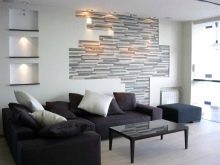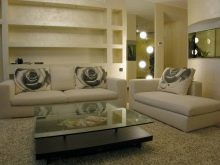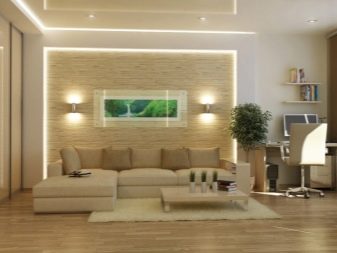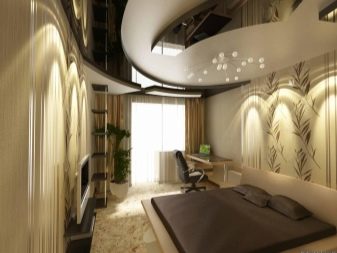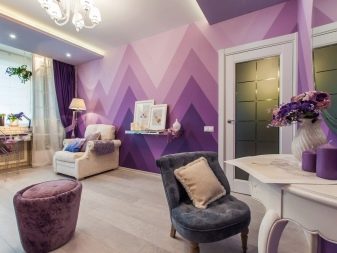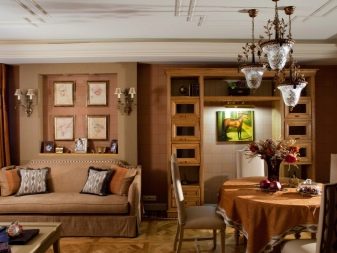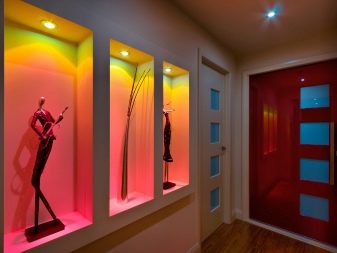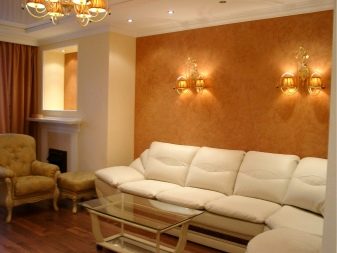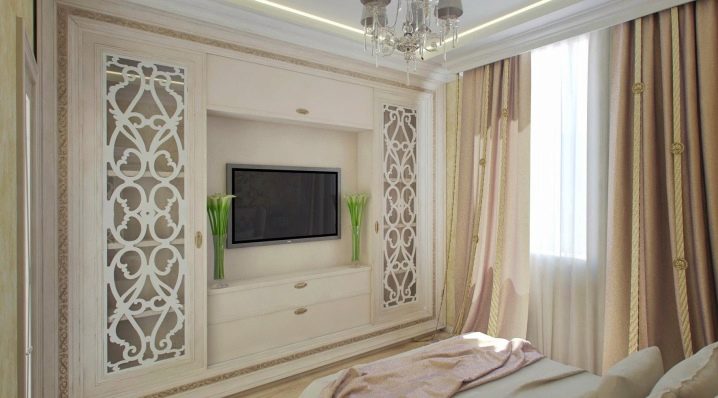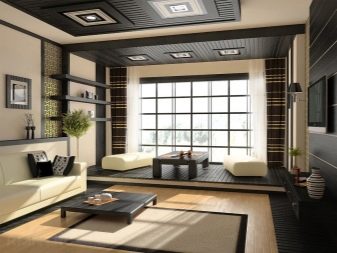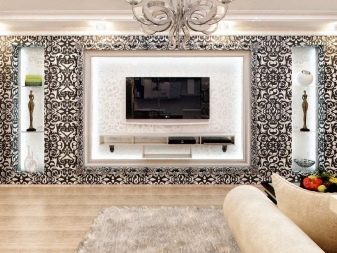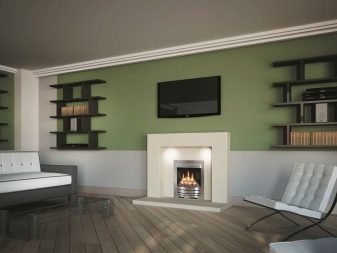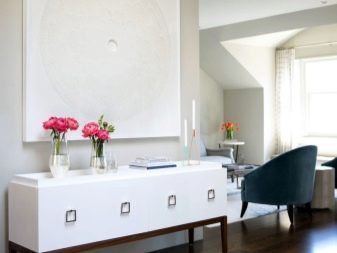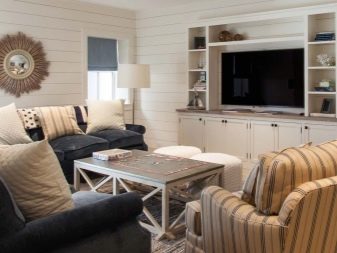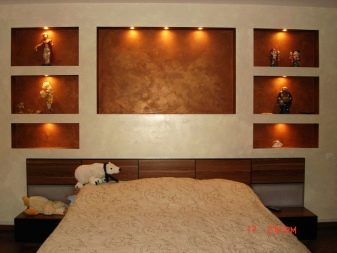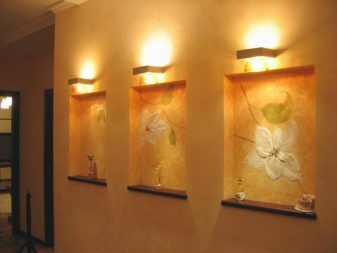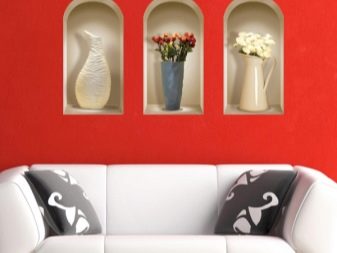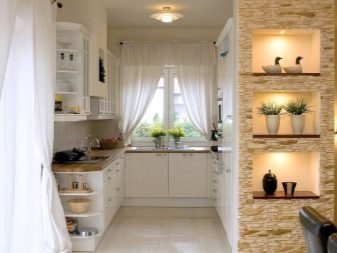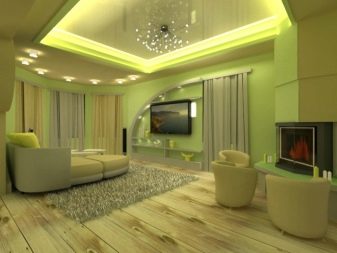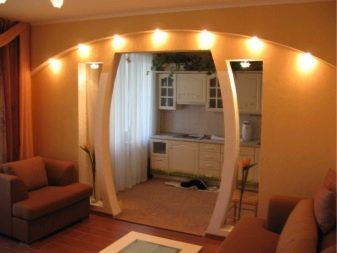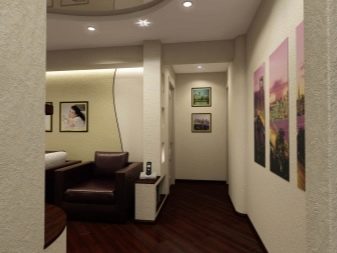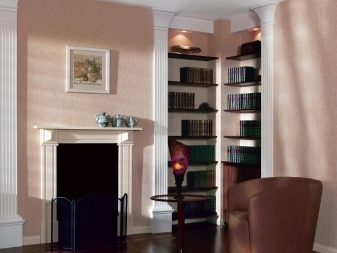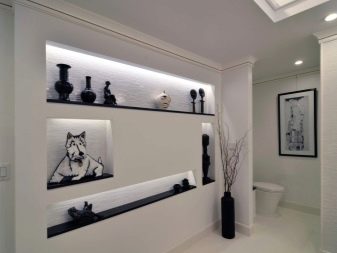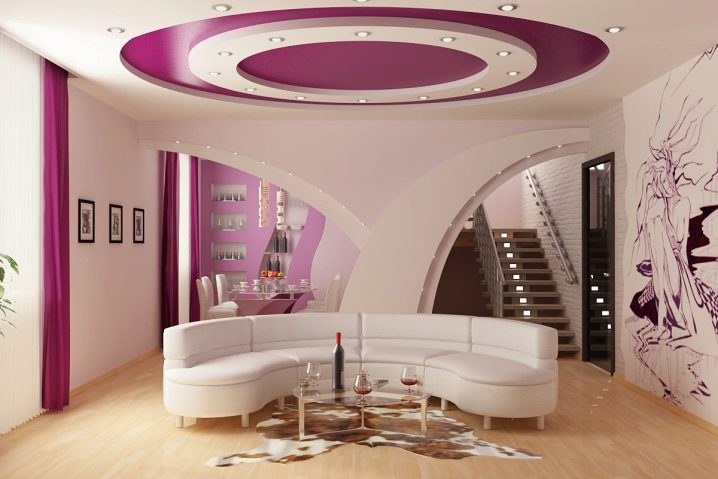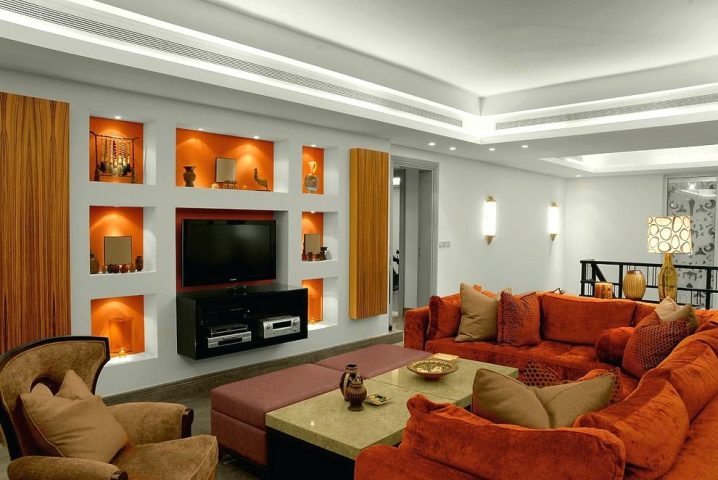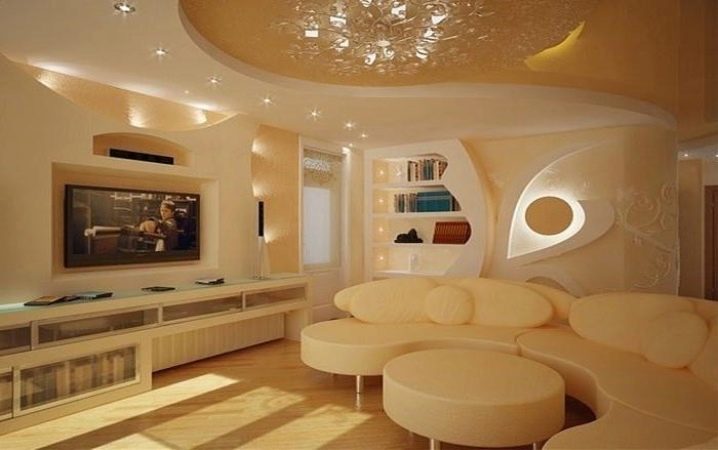Plasterboard niches in the living room interior
The living room is the heart of the house, and the design of the living room with a niche is ideal for those who want to make their interior refined and spectacular. The plasterboard design brings its unique touch to the general appearance of the room, adds uniqueness to the internal space. The ease of material and installation allows you to arrange a niche almost anywhere.
Functionality
Decorative niches provide a lot of possibilities in the living room interior:
- Constructions of drywall can visually lengthen the walls or pull the height of the ceilings, such a technique is often used in non-standard rooms.
- Walls with niches and windows allow you to zone the room. Every household, whether a teenager or an elderly person, requires a personal living space, where he could retire.A plasterboard module even in a tiny room can isolate a recreation area: a sleeping place, an aquarium, a section with a TV.
- Niches allow you to hide the defects of the walls and ceiling space, they themselves create the necessary stylistic accents in the interior, making it more original and exclusive.
- Owners are provided with a place to store accessories, figurines and memorable gizmos dear to the heart. Depending on the size of the niches, they perfectly accommodate household appliances and electronics, furniture and other household items (beds and armchairs, stereos, fireplaces, televisions).
- Gypsum plasterboard designs not only serve as an element of the hall's décor, but also save money that would have been spent on leveling the walls and buying cabinets, shelves, drawers and other storage systems.
- Thanks to the built-in LED backlight, you can use a niche as a night light.
- Step transitions from plasterboard allow you to create an interesting design of the ceiling space, simplify the installation of spotlights.
- Drywall modules do not occupy as much living space as cabinet furniture, which is important for miniature rooms.
What can be placed in niches?
Before you start to equip niches in the living room, it is worth deciding what exactly you are going to place in them:
- These can be flower vases, figurines, memorable photographs of loved ones, cute trinkets brought from vacation, or souvenirs donated by a loved one.
- In the interior of a niche, you can install shelves of wood or glass, which will house plants, photo frames and favorite books. Even the whole library will be organized in a separate module.
- Plasterboard design allows you to hide unpresentable communications systems - batteries, hoods. Happy owners of fireplaces often frame them with niches.
- They are perfectly placed massive parts of furniture: cabinets, sofas, chairs, computer desks.
Species
Plasterboard niches can be an interior decoration in any existing style, because you can arrange them in any wall: whether it is brick, concrete or plasterboard.
All facilities are divided into:
- Horizontal - they are able to visually expand a narrow wall, a tandem with a long low furniture (sofa, dresser) will be harmonious.
- Vertical - pull the room up, it is appropriate to place them next to a massive cupboard, window, door.
- Ceiling - give the speakers a ceiling space, allow the use of additional built-in lighting.
- Outdoor - performed traditionally at the level of 70-80 cm from the floor. This is one of the latest fashion trends. In such modules, you can place spectacular decorative vases or pots with indoor plants, porcelain figurines.
Several niches in one living room must be in harmony with each other and correspond to the general stylistic decision.
Depending on the purpose of construction of drywall divided into functional and decorative. The first is used to embed appliances, furniture, communication systems, various accessories. The latter are themselves an interior decoration, such niches can have unusual shapes, intricate color lighting, for their design they often use stained glass windows or decorative inserts made of flowers.
Decor and decoration
The original recess in the wall, you can use different textures or their combination:
- Painting - One of the most popular ways to finish.Contrasting bright colors will allow you to make accents in the room, shades to match the wall are suitable for creating a quiet cozy atmosphere in a small living room. In the latter case, the backlight is required.
- Decorative plaster - when applied in several layers creates a 3D effect.
- Patterned Stickers are the most budget option, which looks advantageous when framing framing.
- In decorating recesses often use textured wallpaper, fabrics, bamboo panels, metal, stone tiles, wood, color mosaic, mural - this facing looks very impressive.
Do not forget about lighting - the play of light and shadow visually expands the space, adds volume to it, highlights objects in the niche interior.
LED threads, halogen lamps, spotlights of all shapes and sizes - the consumer has a wide choice of lighting options.
Secrets of choice
Masters in the field of interior design know how to choose a drywall module for your interior.
- When choosing a place for deepening, you need to take into account the location and height of the furniture so that it does not cover a niche.
- Before installing the module, conduct electricity so that the cable and wires are hidden behind the wall of the future niche.
- When choosing a facing material for repair, keep in mind that without proper lighting a niche will turn into a black hole. You should not choose shades for it darker than the wall itself.
- For a small living room a lot of recesses in the wall will look hard. Harmony in the room is out of the question.
- The choice of material and shape of a niche is directly influenced by its location. The modules near the doorway and in the interior partitions may look completely different.
- Designs must comply with the design idea. If the main function of consoles is decorative, you should focus on all the attention in the interior. At arrangement of deepenings it is worth using as much as possible illumination, bright paints, unusual decorative elements.
- If the niche is intended for technology, it should be securely mounted on the wall and supported on the floor. The supporting surface is enhanced in terms of double margin of safety.
- Particular attention should be paid to sound insulation, because drywall is a good conductor of sound. Columns and speakers are placed in niches equipped with sound insulation made of mineral wool or polystyrene.
Beautiful ideas in the interior
In the modern interior a niche in the wall has become mainstream. Stylish designs of drywall can be found in a spacious country mansion, and in the living room miniature "Khrushchev" - and this is considered the norm.
So, in a spacious bright room, the recesses in the wall contributed to the creation of a small home library where collections of favorite authors were located. For people who are not devoid of artistic taste, bookshelves - an essential attribute of the house. And the neighborhood of shelves with a cozy fireplace, located in a corner niche, allows households to enjoy the comfort of literary fiction in the icy winter evenings.
Niches, painted in a shade of juicy orange, with intense illumination form a good tandem with terracotta furniture of the room. Such a color accent of the plasterboard construction allows you to effectively emphasize the ethnic figurines and souvenirs located in it.
The module in the form of a butterfly wing on the wall allows us to remind once again that niches can play the role of only a decorative element. Due to the delicate illumination of the insect, it is appropriate to use it as a night light. Concisely built-in plasterboard shelves for books and TVs complement the console.
In the snow-white room, made in the marine style, the compartments of the niches are located along the perimeter of the arched door, as if hinting at the ship's steering wheel.
For information on how to choose a niche from drywall in the living room interior, see the following video.


